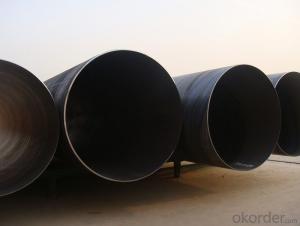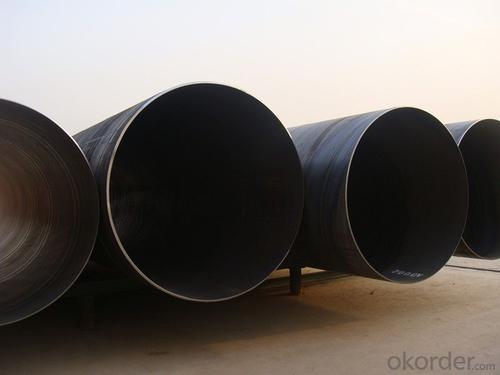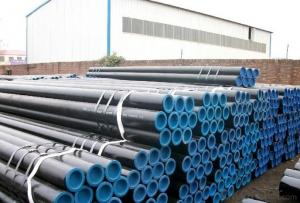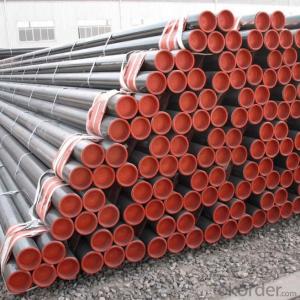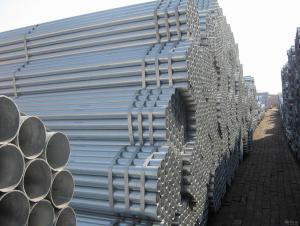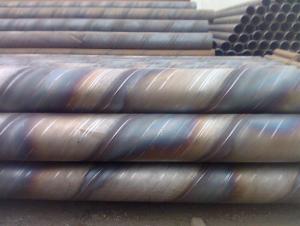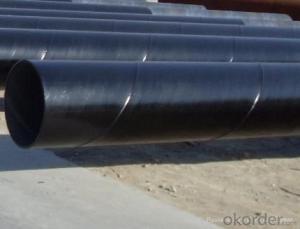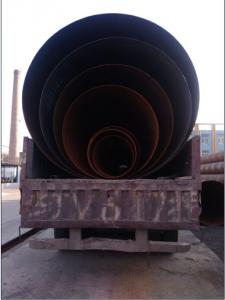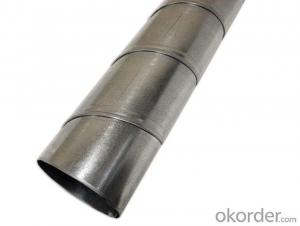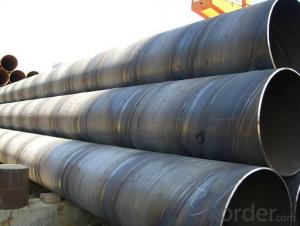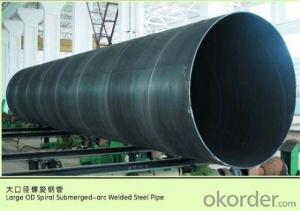SPIRAL STEEL PIPE 32’‘ CARBON ASTM API DIN ISO
- Loading Port:
- China Main Port
- Payment Terms:
- TT OR LC
- Min Order Qty:
- -
- Supply Capability:
- -
OKorder Service Pledge
OKorder Financial Service
You Might Also Like
Packaging & Delivery
Packaging Detail: | standard export packing or as customer's requirement |
Delivery Detail: | within 10 - 30 days |
Specifications
Spiral Welded Steel Pipes and Tubes
1.Material:Q195-Q235
2.Length:1-12m
3.WT:1.0-14mm
4.O.D.:20-273mm
Spiral Welded Steel Pipes and Tubes
Product Description:
1.Material : Q235,Q345,L245,L290,L360,L415,L450,L485,GrB,X42,46,X52,X56,X60,X65,X70,X80,X100
2,Standard: SY/T5037-2000,GB/T9711-2011,API Spec 5L PSL1/PSL2,ASTM A252\A53,ISO3183,DIN17172,EN10217,JIS G3457,AWWA C200,ASTM A139,ASTM A671,ASTM A672
3.Wall thickness: 3.0mm-30mm
4.Outer diameter: φ168mm-3020mm
5,Length: 5m-12m or as your requirement
6,Corrosion protection standard: DIN30670,DIN30671, AWWAC210, AWWA C203, SY/T0413-2002,SY/T0414-2002
7,Application: Oil, gas, natural gas, water pipe, thermal electricity pipe, steel structure engineering, etc
Q195-q345 Material Steel Pipe's Materials
Elements | Chemical Compsition% | Mechanical Property | ||||||
| C% | Mn% | S% | P% | Si% | Yield Point (Mpa) | Tensile Strength(Mpa) | Elongation |
Q195 | 0.06-0.12 | 0.25-0.50 | <0.050 | <0.045 | <0.030 | >195 | 315-430 | 32-33 |
Q215 | 0.09-0.15 | 0.25-0.55 | <0.05 | <0.045 | <0.030 | >215 | 335-450 | 26-31 |
Q235 | 0.12-0.20 | 0.30-0.70 | <0.045 | <0.045 | <0.030 | >235 | 375-500 | 24-26 |
Q345 | <0.20 | 1.0-1.6 | <0.040 | <0.040 | <0.55 | >345 | 470-630 | 21-22 |
- Q: Material of welded steel pipe
- GB/T3091-1993 (galvanized steel pipe for low pressure fluid delivery). Mainly used to transport water, gas, air, oil and heating, hot water or steam, etc. generally lower pressure fluid and other use tube. Its representative material is Q235 grade a steel.
- Q: How are steel pipes used in the power generation industry?
- Steel pipes are used in the power generation industry for a variety of applications, including transporting fluids such as steam, water, and fuel gases, as well as for structural support in power plants and for cooling systems.
- Q: How are steel pipes used in the construction of underground parking structures?
- Steel pipes are commonly used in the construction of underground parking structures for various purposes such as drainage systems, ventilation, plumbing, and structural support. The pipes are utilized to facilitate the efficient flow of water and sewage, provide ventilation to ensure air circulation and remove harmful gases, supply water to different areas of the structure, and offer stability and strength to the overall construction.
- Q: How are steel pipes used in the construction of pipelines?
- Steel pipes are commonly used in the construction of pipelines due to their high durability, strength, and ability to withstand high pressure. These pipes are used to transport various fluids, such as oil, gas, and water, over long distances. They are welded together and laid underground or submerged to create a reliable and efficient transportation system for these resources.
- Q: What are the different methods of pipe bending for steel pipes?
- There are several methods of pipe bending for steel pipes, each with its own advantages and limitations. 1. Manual Pipe Bending: This method involves using hand tools or a manual pipe bender to bend the steel pipe. It is suitable for small-scale projects or when only a few bends are required. However, it requires skill and precision to ensure accurate and consistent bends. 2. Rotary Draw Bending: This method utilizes a mandrel, clamp die, and a bending die to bend the pipe around a stationary bend die. The mandrel helps to maintain the shape and prevent wrinkling or collapsing of the pipe during the bending process. Rotary draw bending is commonly used for producing tight-radius bends with high accuracy and repeatability. 3. Induction Pipe Bending: In this method, an induction coil is used to heat a specific area of the steel pipe, making it more malleable for bending. Once the desired temperature is reached, the pipe is bent using hydraulic or mechanical force. Induction bending is suitable for large-diameter pipes or when multiple bends are required in a single pipe. 4. Roll Bending: Also known as pyramid rolling, this method involves passing the steel pipe through three adjustable rolls that gradually bend the pipe into the desired shape. Roll bending is suitable for producing large-radius bends and is commonly used in the construction of spiral staircases, handrails, and structural applications. 5. Hot Bending: This method involves heating the steel pipe to high temperatures, typically using a furnace, to facilitate bending. Hot bending allows for greater flexibility in shaping the pipe and is commonly used for large-diameter or thick-walled pipes. However, it requires specialized equipment and expertise to control the temperature and prevent distortion or damage to the pipe. It is important to consider factors such as the required bend radius, pipe diameter, wall thickness, and project specifications when selecting the appropriate method of pipe bending for steel pipes. Consulting with an experienced pipe bending professional or engineer can help determine the most suitable method for a specific application.
- Q: What is the weight of a steel pipe?
- The weight of a steel pipe can vary depending on its dimensions and thickness.
- Q: Which is better, galvanized steel pipe or stainless steel?
- Most of the use requirements are to maintain the original appearance of the building for a long time. In determining the type of stainless steel to be chosen, the main consideration is the aesthetic standards required, the corrosivity of the atmosphere in the area, and the cleaning system to be adopted. However, other applications increasingly seek only structural integrity or watertightness. For example, the roof and side walls of industrial buildings. In these applications, the construction cost of the owner may be more important than the aesthetic, the surface is not very clean can also. The use of 304 stainless steel in a dry indoor environment is quite effective.
- Q: Is there any difference between thermal expansion seamless steel pipe and seamless steel pipe?
- Seamless tubes are generally produced on continuous tube mills, also known as automatic rolling mills. The round steel is cut into the required length, centering on the end face of the pipe blank and then sent to the heating furnace to punch on the piercer. At the same time, the hole rotates and advances continuously. Under the action of the roller and the plug, the inner cavity of the pipe blank is gradually formed, and the cavity is called the capillary. Sent to the automatic tube rolling mill on rolling. Finally, the thickness of the whole machine is the same, and the diameter of the sizing machine is determined to meet the specifications.
- Q: Can steel pipes be used for fencing?
- Yes, steel pipes can be used for fencing. They are a popular choice for fencing due to their strength, durability, and ability to withstand harsh weather conditions. Steel pipes provide a sturdy and secure barrier, making them suitable for various fencing applications such as residential, commercial, and industrial settings.
- Q: What is the difference between steel pipe and PVC conduit?
- Steel pipe is a rigid and durable material commonly used for plumbing and industrial applications. It is made of steel, which provides strength and resistance to high pressure and temperature. On the other hand, PVC conduit is a type of plastic piping that is flexible, lightweight, and non-conductive. It is primarily used for electrical installations, as it offers protection and insulation to the wires. The main difference between steel pipe and PVC conduit lies in their composition, rigidity, and purpose of use.
Send your message to us
SPIRAL STEEL PIPE 32’‘ CARBON ASTM API DIN ISO
- Loading Port:
- China Main Port
- Payment Terms:
- TT OR LC
- Min Order Qty:
- -
- Supply Capability:
- -
OKorder Service Pledge
OKorder Financial Service
Similar products
Hot products
Hot Searches
Related keywords
